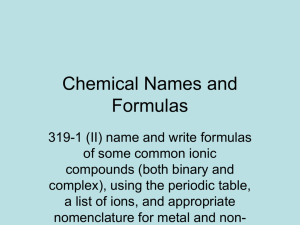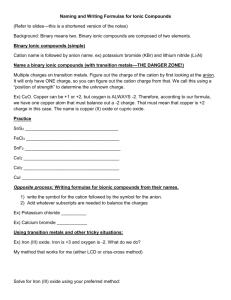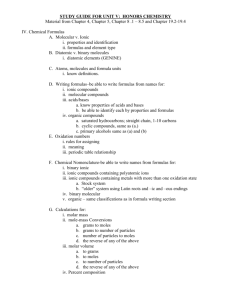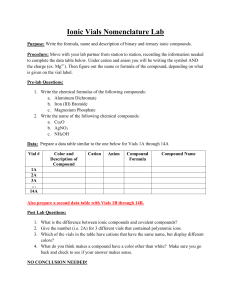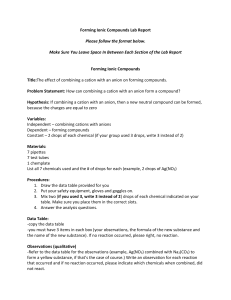Writing Formulas & Names for Binary Compounds
advertisement
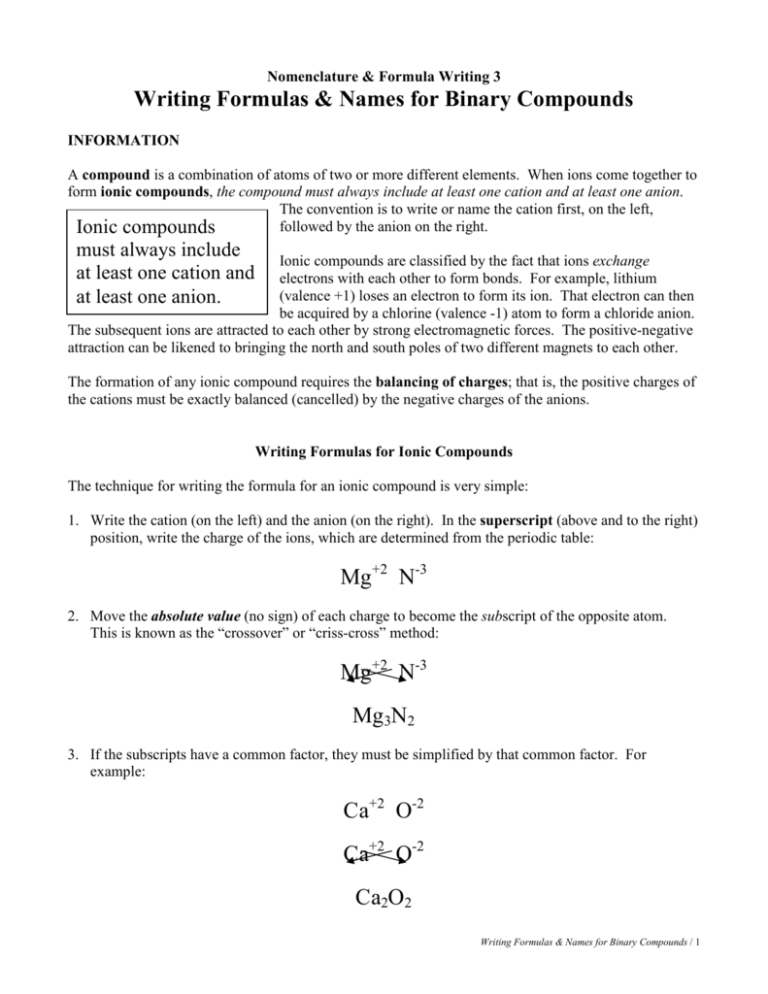
Nomenclature & Formula Writing 3 Writing Formulas & Names for Binary Compounds INFORMATION A compound is a combination of atoms of two or more different elements. When ions come together to form ionic compounds, the compound must always include at least one cation and at least one anion. The convention is to write or name the cation first, on the left, followed by the anion on the right. Ionic compounds must always include at least one cation and at least one anion. Ionic compounds are classified by the fact that ions exchange electrons with each other to form bonds. For example, lithium (valence +1) loses an electron to form its ion. That electron can then be acquired by a chlorine (valence -1) atom to form a chloride anion. The subsequent ions are attracted to each other by strong electromagnetic forces. The positive-negative attraction can be likened to bringing the north and south poles of two different magnets to each other. The formation of any ionic compound requires the balancing of charges; that is, the positive charges of the cations must be exactly balanced (cancelled) by the negative charges of the anions. Writing Formulas for Ionic Compounds The technique for writing the formula for an ionic compound is very simple: 1. Write the cation (on the left) and the anion (on the right). In the superscript (above and to the right) position, write the charge of the ions, which are determined from the periodic table: Mg+2 N-3 2. Move the absolute value (no sign) of each charge to become the subscript of the opposite atom. This is known as the “crossover” or “criss-cross” method: Mg+2 N-3 Mg3N2 3. If the subscripts have a common factor, they must be simplified by that common factor. For example: Ca+2 O-2 Ca+2 O-2 Ca2O2 Writing Formulas & Names for Binary Compounds / 1 In this case, she subscripts have a common factor of 2. To simplify, divide both subscripts by the common factor: Ca2/2O2/2 This yields: Ca1O1 4. If any subscript is a “1”, it is not written (it is an assumed 1, like x is assumed to be 1x in algebra). So: CaO This type of compound is called a binary compound. The formulas above represent single units of this compound. Single units of ionic compounds are referred to as formula units (as opposed to molecules, which is a term reserved for covalent compounds). In the same way that a molecule is the smallest unit of a covalent compound, a Single units of ionic formula unit is the smallest unit of an ionic compound. compounds are called Charge Balance formula units. It is important to understand that the ratios in which ions combine is a result of the ions’ attempts to neutralize their overall charge. In the calcium oxide (CaO) example above, the calcium ion begins the process with a charge of 2+, and the oxygen begins with a charge of 2-. Combining one of each type of ion – which pairs a 2+ charge with a 2- charge – results in the charges cancelling each other out and resulting in a neutral charge for the formula unit. This will be the case for any neutral ionic compound – the charges of all of the ions involved in forming the compound will cancel each other out. This is a simplified explanation of this phenomenon, and is covered in more detail in the series of activities on Bonding. Naming Binary Compounds Determining the name of a binary compound is straightforward. It is comprised of two parts – one to identify the cation (metal), and one to identify the (anion) nonmetal. 1. The cation (metal) keeps its complete name. Continuing with the example from above, the first part of Mg3N2 is called magnesium. 2. The anion is named slightly differently. The nonmetal name is truncated to include only the root, and the ending –ide is added. This holds for all nonmetals in binary compounds. The nonmetal in the above example is nitrogen. The root is nitr-, so the second component of the name is nitride. 3. The complete name of the compound is magnesium nitride. Writing Formulas & Names for Binary Compounds / 2 Nonmetal Roots Arsenic Bromine Carbon Chlorine arsenbromcarbchlor- Fluorine Iodine Nitrogen Oxygen fluoriodnitrox- Phosphorus Selenium Sulfur phosphselensulf- Key Questions: 1. In grammatically correct English, explain why noble gases do not form ionic compounds. Use what you have learned about valence, ions, and compounds to support your explanation. 2. In grammatically correct English, write detailed procedures for a) writing formulas and b) naming binary compounds. Assume that the procedures will be used by someone who has no prior knowledge of this material. Exercises 3. Write the formulas for the following compounds: a. Sodium chloride b. Strontium phosphide c. Lithium bromide d. Aluminum sulfide 4. Write the names for the following compounds: d. AlCl3 a. KBr e. Ra3P2 b. Be3N2 c. SrBr2 f. CaI2 e. f. g. h. Beryllium iodide Indium oxide Rubidium arsenide Cesium nitride g. Rb2O h. Ba3P2 5. Some of the formulas and names below are written incorrectly. Identify those that are incorrect and write them properly. a. NaI2 e. Rubidiumide fluoride b. Potassium sulfur f. Fr3P c. CsCl g. Ra2O2 d. In2O3 h. Ge4N3 Writing Formulas & Names for Binary Compounds / 3 Student Name: ____________________________________________ Pd. ______ Date: ____________ Supplemental Exercises Binary Naming and Formula Writing Write the correct name for the following compounds. 1. BaCl2 10. Li2S 19. Sr3P2 2. NaBr 11. RaCl2 20. BeBr2 3. MgF2 12. CaO 21. AlP 4. Na2O 13. RbI 22. K2S 5. SrS 14. CaBr2 23. LiBr 6. BN 15. LiI 24. AlN 7. NaI 16. MgS 25. K2O 8. SrF2 17. KBr 26. SrI2 9. CaF2 18. Ba3N2 27. Al2S3 Write the correct formula for the following compounds. 28. sodium oxide 37. magnesium oxide 46. cesium sulfide 29. magnesium iodide 38. lithium bromide 47. potassium chloride 30. lithium chloride 39. calcium nitride 48. strontium phosphide 31. beryllium bromide 40. calcium fluoride 49. barium iodide 32. aluminum sulfide 41. potassium iodide 50. rubidium oxide 33. calcium bromide 42. strontium chloride 51. calcium iodide 34. beryllium oxide 43. sodium sulfide 52. cesium oxide 35. strontium sulfide 44. radium bromide 53. calcium fluoride 36. calcium fluoride 45. magnesium sulfide 54. aluminum oxide Writing Formulas & Names for Binary Compounds / 4
